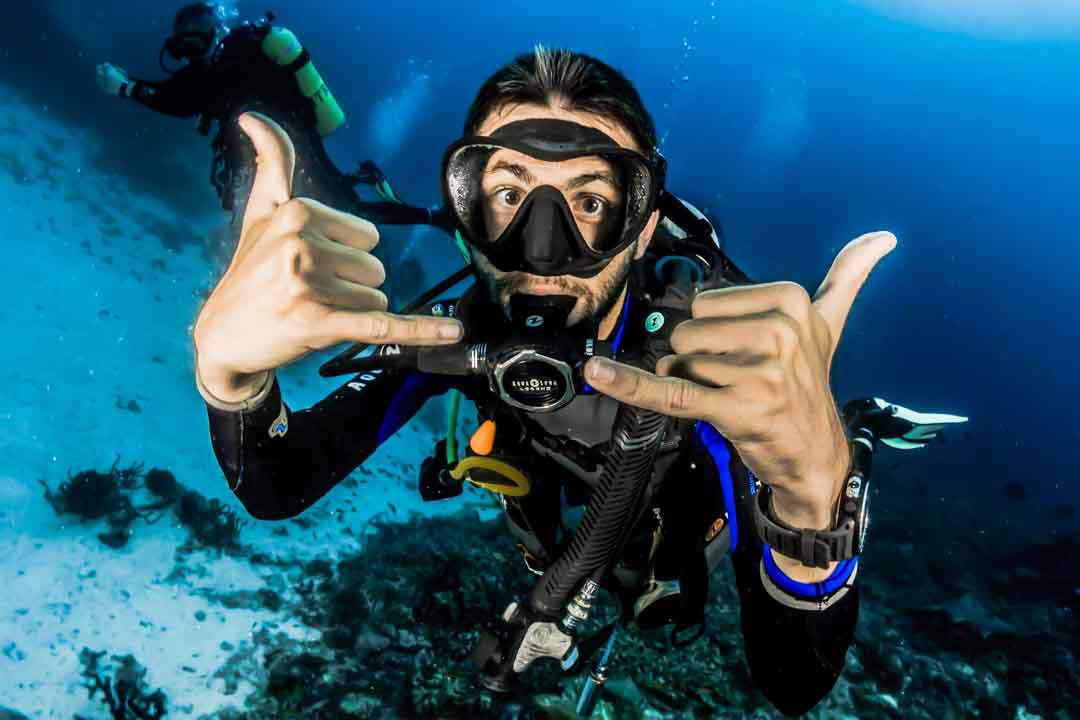There’s quite a choice of wetsuits. We’ve prepared this guide to help you choose the right suit for you and the conditions in which you dive.
In this guide, we cover the best wetsuits for scuba diving for men, if you’re looking for a female-specific wetsuit reviews head over to our guide of women’s wetsuits. Otherwise, here’s our wetsuit ratings for the best wetsuits 2023.
ALL THE WETSUITS FOR MEN THAT WE TESTED
DARK LIGHTNING Full Body Wetsuit
General Impression
The Dark Lightning Full Body wetsuit comes in an astonishing 25 different sizes, so it’s fit for just about any body shape. It’s a 2/3mm wetsuit, made from a combination of nylon and neoprene that’s stretchy, soft to the touch, and molds around your body. It has a YKK zipper in the back for easy putting on and taking off which are rated the best wetsuits for diving.
Specifications
ZIP: YKK zipper
MATERIAL: Neoprene
THICKNESS: 3/2mm and 5/4mm
SUITABLE FOR: Scuba diving in a variety of locations
PROS
- YKK Zipper in the Back
- This best wetsuits for diving comes in 25 different sizes
- Rated best mens wetsuits
CONS
- Velcro at the back of the neck doesn’t seal 100%
O'NEIL Reactor 2
General Impression
The O’Neil Reactor II is an upgraded version of the previous Reactor. It’s more durable, stretches more easily, and is incredibly soft on the skin. It zips in the back so it’s easy to put it on and take it off. The wind-resistant smooth skin also provides additional insulation to keep you warm even in colder weather and rated amongst the best wetsuits for diving.
Specifications
ZIP: YKK, in the back with leash
MATERIAL: Neoprene Rubber
THICKNESS: 3/2mm
SUITABLE FOR: Scuba diving in cooler water
PROS
- 3/2mm Neoprene Rubber
- Wind-resistant smooth skin
- Ideal as best beginner wetsuits for different sports
CONS
- Only the back and chest are smooth skin neoprene
SCUBAPRO Everflex
General Impression
ScubaPro is one of the best scuba diving wetsuits brand. They have used every trick in the book to deliver a wetsuit that is flexible, comfortable, and warm.
Made from ScubaPro X-Foam, the ScubaPro Everflex uses pre-formed shapes the reduce the number of seams giving great movement and thermal protection. The outer seams have been double blind stitched, and the inner are single, which reduces water flow to almost zero. Over the torso Heliospan lining traps water for insulation, elsewhere Diamond Span lining assists draining once out of the water. Wrist and ankle seals are zippered and use Glideskin so that you can layer gloves and boots effectively. The neck seal uses Glideskin too plus there’s a short front zip at the throat for increased comfort. The rear zip is by YKK. The zip has a flush guard and padding and runs in a diagonal for comfort and ease of getting in and out. The shoulders and knees are padded, and the knee and bum area has extra protection.
X-Foam neoprene has been designed specifically for scuba diving to be flexible, warm, and water shedding. It’s the only neoprene that complies with PAH testing which means it’s both hypoallergenic and environmentally friendly.
Specifications
ZIP: YKK, diagonal across back with leash
MATERIAL: X-Foam
THICKNESS: 3/2 mm and 5/4 mm
SUITABLE FOR: Scuba diving in a variety of locations
PROS
- Diagonal back zip
- Hypo-allergenic and eco-friendly
- Uses flexible, warm, X-Foam with Glideskin seals and blindstitching
CONS
- Zippers on the hands stiffen up some of the motion in the wrists
CRESSI Morea
General Impression
The CRESSI Morea suit is ideal for diving in the tropics. This suit uses large panels for great flex. The body is made from a rubberized neoprene which not only keeps the core warm but dries quickly. The arms and legs are lined with Ultraspan, which is a nylon lining designed for ease of movement. The back zip is YKK and has a flap to reduce water flow and a leash to aid with zipping. The knees have a protective cover against abrasions. Wrists and ankles have an overlocked cuff to seal and reduce water flow which rates this wetsuit amongst the best wetsuits brands.
Specifications
ZIP: YKK, vertical, rear
MATERIAL: Various
THICKNESS: 3mm
SUITABLE FOR: Diving in the tropics, snorkeling, freediving
PROS
- Ultraspan lining
- YKK Zip
- Overlocked cuffs
- Top best beginner wetsuits
CONS
- Seam in the sleeve tends to irritates one’s elbow pit
HENDERSON Men’s Thermoprene Jumpsuit
General Impression
Thermoprene is Henderson’s bespoke neoprene which has been created for ease of getting into and out of. Seams are glued and blind stitched to reduce water seepage. The zip is YKK, has a leash, and is fitted at the rear running vertically. There’s padding along the spine, and the cuffs feature lycra finishing for comfort. The knees are padded and coated to resist abrasions. Wrists and ankles have an overlocked cuff to seal and reduce water flow. Amongst wetsuits brands, Henderson’s is one of the smaller companies but has a long tradition of producing cool wetsuits.
Specifications
ZIP: YKK, vertical, rear, padded with a leash
MATERIAL: Neoprene
THICKNESS: 3mm
SUITABLE FOR: Diving in the tropics, snorkeling, freediving
PROS
- YKK Zip
- Padded spine
- Glued and blindstitched seam
CONS
- Wetsuit might not be warm enough for some divers
MARES Men’s Flexa
General Impression
The Mares Flexa features three different thickness of neoprene for warmth and comfort: 5, 4, and 3 mm. It’s as easy to wear as a 3 mm suit but has the thermal protection you would expect from the 5 mm. The neoprene is 100% ultrastretch and has a thermo plush lining. The zip runs vertically up the back and is padded with an extra layer of neoprene for comfort.
Specifications
ZIP: Rear, vertical and padded
MATERIAL: Neoprene
THICKNESS: 5/4/3 mm
SUITABLE FOR: Cooler Water
PROS
- 5/4/3
- Thermo Plush lining
- Padded zip
CONS
- Sizing issues sometimes
XCEL Mens Axis
General Impression
This Xcel suit is a full body wetsuit with a clean no fuss look. The neoprene is a Japanese Limestone Superprene designed to fit like a second skin and offers great stretch. Seams are glued and blind stitched and stress points have been reinforced with FusionX tape. It’s a great value, sleek looking, lightweight wetsuit. An ideal suit if you are looking for a layering combination.
Specifications
ZIP: Rear
MATERIAL: Nylon
THICKNESS: 4/3mm
SUITABLE FOR: When 5mm is too much, but 3mm is not enough
PROS
- Japanese Limestone Superprene
- Smart, clean design
CONS
- Design might be too simple for some divers
HEVTO Guardian
General Impression
The HEVTO Guardian wetsuit is specifically made for beginner divers. It’s made from foamed neoprene on the outside for insulation and improved buoyancy. It’s soft on the skin and other than protecting you from cold it also protects you from sunburns and any abrasion that could arise in open water. Aside from diving, the wetsuit is great for other water sports like kayaking, surfing, and swimming among others.
Specifications
ZIP:
MATERIAL: Neoprene SBR and 2 layers of Nylon
THICKNESS: 3mm
SUITABLE FOR: Cooler water
PROS
- Comes in multiple colors
- Has a two-part version as well with a jacket and pants
CONS
- Sizing chart is a little off
CRESSI Pentagon
General Impression
This suit is made with Cressi NeoPro material, which is durable, elastic, and soft. The lining is Cressi’s patented Ultaspan nylon. The cut is ergonomic, which aids with ease of donning and doffing. The rear YKK zip runs vertically and has a flush guard and leash. The knees have extra protection from abrasions. The neck is shaped to fit and features a Velcro fastening. It’s one of the best wetsuits for diving that doesn’t break the bank.
Specifications
ZIP: YKK, rear vertical, with flush guard and leash
MATERIAL: Various
THICKNESS: 3mm
SUITABLE FOR: Cooler Water
PROS
- Shaped neck with Velcro fastening
- Flush guard on the zip
CONS
- Needs better reinforcement on the knees instead of just vinyl
BARE Elastek Full Suit
General Impression
Bare’s Elastek range is designed to stretch and fit for comfort. Their design employs 3D shape patterning for anatomically correct fit. Seams are taped using SEAMTEK liquid tape on the outside which waterproofs them but also protects from unraveling. The rear zip is double sealed and padded. Bare has a patented PROTEKT material which they have used on the shoulders, elbows, and knees to reinforce these areas against abrasions. The inner elbow and knee backs have flex panels for ease of movement. The ankle and wrist seals use Glideskin.
Specifications
ZIP: Back with a leash
MATERIAL: Neoprene
THICKNESS: 7mm
SUITABLE FOR: Diving in cooler water
PROS
- External liquid SEAMTEK taping
- Flex panels
CONS
- Design is a little bit loose around the calves for those with small calves
BEST WETSUITS FOR MEN
Buyer's Guide
There are a few things to know and consider when choosing the best wetsuits. Below you will find information to help you choose the best wetsuits. We’ve covered the types of suits available as well as a guide to temperature and the key features to consider when reading a wetsuit review.
How do wetsuits keep you warm?
A wetsuit keeps you warm because it traps a layer of water between you and it. Your body warms the water, and the wetsuit keeps it in place. Hence why it’s essential that a suit fits well, if it’s baggy, the water you warm will flow out and chill you as it carries your body heat away.
Wetsuit Fit
To work effectively, best wetsuits needs to fit snuggly but not so snugly that your breathing or circulation are restricted.
New wetsuits are a struggle but don’t assume it’s too tight because you have to wriggle into it. The critical thing to do is to take your time and work slowly. They do begin to fit more comfortably with wear but don’t make the mistake of going up a size to make it easier to get on. Remember, if it’s loose, it won’t keep you warm.
Because cut and fit are so crucial to a wetsuits effectiveness, if you’re female, please take a look at our best women’s wetsuit guide.
Types of Wetsuit
This guide focuses on full-length suits. Rash vests and shorty wetsuits can be used in combination with full suits to give you some flexibility for varying water temperatures. We have offered a summary of them too.
Rash Vest
A rash vest is a thin, stretchy t-shirt like garment. Choose them for tropical waters where you don’t need to keep warm but do need protection from the sun. Rash vests offer protection against stingers too. When worn underneath a wetsuit, rash vests provide increased comfort and immediate sun protection after you remove your wetsuit.
Shorty Wetsuit
Typically, shorty best wetsuits are made using 2-3mm neoprene and are designed to give your core a little extra warmth. Shorty wetsuits are easier to get on and off, but they’re only suitable for warmer waters where you don’t need a lot of thermal protection. Most styles cut off above the knee and elbow, which means you have less sun protection. Their cut also makes for some interesting tan lines.
A shorty wetsuit is great for layering. If you dive in a variety of conditions you can wear a shorty under or over a long wetsuit for extra warmth.
Long Wetsuits
Long best wetsuits, as the name suggests, fit to the ankles and the wrists. These come in a variety of thicknesses allowing you to choose a suit based on the conditions in which you dive. Many scuba divers refer to long wetsuits as full-body wetsuits or jumpsuits.
Semi-Dry Wetsuits
These are usually 7 mm or thicker, and they’re a hybrid of a wet and dry suit. Yes, you will get wet, but the seals and zips are fashioned on a dry suit design to restrict water flow. Most commonly the main zip is the same as a dry suit zip, and it runs horizontally across your shoulders.
Two-Piece Wetsuits
The majority of suits are one-piece, but two-part suits are available. A two-piece suit is made up of a top and a bottom. The bottom covers the legs and comes up to fasten over the shoulder in a dungarees fashion. The top can have an integrated hood and fastens with a beavertail which comes through the crotch to fasten at the front. This fastening is necessary to stop the top riding up, but some find it uncomfortable. These styles can offer increased warmth in the core as both parts overlay.
Key Wetsuit Features:
Neoprene Types
Wetsuits are made using neoprene;
- The best wetsuits are made from good quality neoprene that resists pressure but is flexible.
- Petroleum-based neoprene is cheaper but less flexible and more prone to rips and tears.
- Metallurgical specialist developed Yamamoto neoprene for triathletes. This unique form of neoprene ensures a rational combination of flexibility, strength, and warmth.
- Open cell neoprene has no internal lining. It bonds well with the skin and traps water well, but it’s not very robust.
Wetsuit Thickness
- Suits are made from 1 mm thick. However, these suits, like rash vests, offer minimal thermal protection but excellent sun protection.
- More commonly, divers opt for wetsuits starting at 3 mm thickness for tropical water.
- A 5 mm wetsuit is the choice for cooler water and is a great all-rounder.
- 7 mm suits are for colder water and come in a semi-dry format too.
- The thicker the neoprene, the better thermal protection it will deliver.
- Thicker neoprene is less flexible and will affect your range of motion.
- Thicker neoprene is more buoyant. You will need to take more weight.
- As you descend, neoprene compresses. Thicker neoprene can increase your speed of descent, requiring you to offset this loss of buoyancy.
As such – when designers consider thickness – they are required to counteract the trade-off between thermal protection and flexibility. Suits come in a variety of thickness options, allowing the consumer to decide what trade-off would best suit them. Thicker materials are used to warm the core, whereas divers use thinner materials where flexibility is required. A 3/2 mm wetsuit means it has 3mm over the core and 2 mm for the arms and legs.
When looking for the best range of motion, look for suits made using large panels. A suit that has a lot of stitching won’t allow as much freedom of movement.
Water Temperature
Choosing the correct suit thickness does depend on your susceptibility to cold. Another critical factor to consider is how long you will spend in the water because the longer you’re in the water, the colder you will get.
Also, temperatures do vary throughout the year, so consider your options for layering.
As a guide, these are the common choices for each water temperature
- 27°C / 80°F – rash vest, shorty or 1 mm suit
- 25°C / 77°F – 3mm full-length suit
- 15-25°C / 59-77°F – 5 mm full-length suit
- 10°C / 50°F – 7 mm wetsuit or semi-dry with hood and gloves
- For colder water, wear a dry suit
Wetsuit Lining
- Wetsuit lining is the internal layer that rests against your skin and assists with thermal protection and comfort.
- Weave is common. It’s soft against your skin. It traps water well and dries quickly for comfort on the surface.
- Titanium maintains heat by reflecting it to your body.
Zips
- Wetsuit zips are made from either plastic or metal. Plastic won’t corrode, but metal is more durable. Look for quality zips like YKK.
- The most common design has a zip running down your spine. Some suits feature an offset back zip which runs diagonally to reduce the pressure from the tank. Rear zips should come with a leash to help you fasten them.
- Front zippered wetsuits have either a vertical or diagonal zip. Some people struggle with front zips due to shoulder mobility. The diagonal version is easier to manage than the vertical design.
- A zip that’s backed with a flush guard stops water flow which keeps you warmer.
- Wrist and ankle zips can make a suit manageable to put on. Wrist and ankle zippered wetsuits that have a double seal have another purpose. Double seals allow you to fit your gloves and booties over the first layer and zip the second layer up over them. These zips slow the water flow as well.
- Semi-dry suits should use a dry suit zip.
Seals – Neck, Wrist, And Ankle
- Wetsuits can have primary neoprene seals. These are like a traditional hem that folds the same material back to make an edge. Basic neoprene seals offer less thermal protection, but they are easier to get in and out of.
- Glideskin is a soft skin-like material that grips kindly to your skin to slow water flow. At the neck, specifically, the width of Glideskin used will affect the suit’s warmth. Options range from a thin edging to a roll neck design that the offers optimum seal.
Stitching
- An overlocked stitch is on the inside. Water can seep through this, so it’s best for warmer water suits.
- A flat stitch looks like train tracks on the outside. Inside, the seam is flat against your skin; this is more comfortable. A flat stitch is more watertight than the overlocked stitch.
- A blind stitch is the optimum stitch for cooler water suits. Seams are already glued and stitched. You can reinforce them with tape, which is ideal for colder waters.
Padding and Grip
- Knee pads offer robust, durable protection. If you’re taking a professional level diving course, you’ll spend a lot of time sitting on your knees. Consider this feature, if this is you.
- Elbow pads are lighter and more flexible than knee pads and offer increased protection for an area that often sees bumps and scrapes.
- Spinal padding offers comfort down your spine where your tank rests.
- Dive wetsuit shoulders sometimes feature grip or protection for BCD wear.
Some suits have extra grip on the bum, which is useful if you dive a lot from RIBs.
Other Features
- Some suits are fitted with pockets on the thigh, which are handy for small accessories or a spare mask.
- Suits are available with wrist strap retainers. These stop your computer, dive watch, or compass moving around.
Extremities
Divers wear gloves, hoods, and booties. Again, these come in different thicknesses. Don’t overlook their value. A hood conserves a surprising amount of heat and will make a significant impact on your warmth.
Scuba Diving Wetsuits Versus Wetsuits for Other Water Sports.
You’re always better to buy a wetsuit made for its particular sport.
Surface sport suits have a different cut as they need to allow the wearer to move in different ways. As an example, a windsurfer would struggle to move in a scuba wetsuit. A scuba diver in a windsurfing suit may find it loser on the shoulders which is not optimal for maintaining warmth.
Surfing suits are often cheaper than diving suits, and they might tempt you. A surf suit would be passable to dive in tropical water but know that surfing suits are made to be flexible. Surf suit manufacturers do not design surfing wetsuits with scuba gear in mind. The surf suit neoprene hasn’t been made to withstand pressure and cannot bear scuba gear. Surf suit neoprene will quickly lose thermal protection as they compress. Whereas, suits for scuba diving are made to stand up better under pressure and retain more of their thermal protection, although they do still compress.
Some tips for your new wetsuit.
- New neoprene is very buoyant. You are very likely to need extra weight, so do a buoyancy check first. If possible, do a checkout dive in shallow calm water.
- The more you dive, the less buoyant it will become. It will lose thermal qualities too, at which time you can consider adding layers or a hood.
- New wetsuits can be particularly problematic to get on. Divers have a range of solutions for this. Baby shampoo can help ease the way, as can a plastic bag over your feet and hands. If you use the bag method; make sure it doesn’t go overboard and is small enough to cover your hand or foot. Use a large bag, and you’ll never free it from your suit.
- Like all dive gear, rinsing in freshwater and hanging to dry is good practice. If you pee in your suit, you might want to consider regular soaking with wetsuit shampoo or disinfectant to keep any odors at bay.
- Note that wet wetsuits become cumbersome, and many scuba divers use reinforced hangers.
- If you’re packing your suit away for a while, make sure it’s thoroughly dry first. Loosely fold it and store it in a cool dark place in a black garbage bag.
REACH OUT
As always, we create our content with you, fellow adventurers, in mind. So, how’d we do? Did you find this informative? Did it help you make a decision? Did we miss anything? We’d love to hear from you below. Thanks for reading and we hope your next adventure is a great one!
































